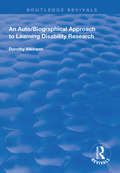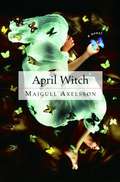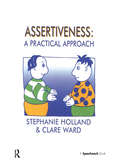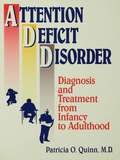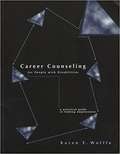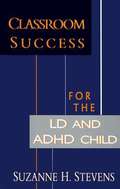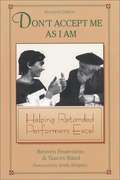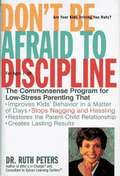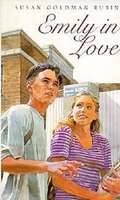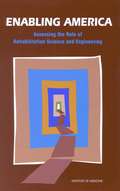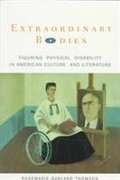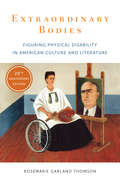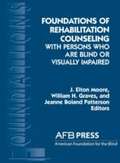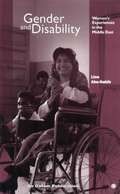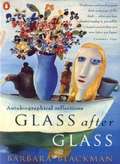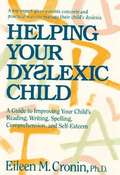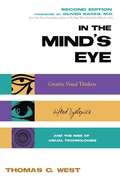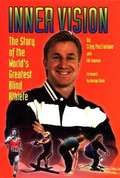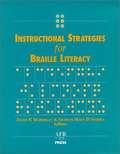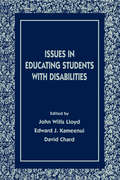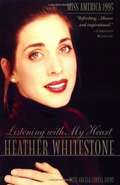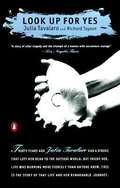- Table View
- List View
An Auto/Biographical Approach to Learning Disability Research (Routledge Revivals)
by Dorothy AtkinsonFirst published in 1997 , Dorothy Atkinson collects testimonies of the personal perspectives of people with learning disability in order to rediscover the histories of people with learning disabilities. Calling on the importance if auto/biographical research as mode to encourage social, historical awareness and potential understanding of the commonalities as well the differences between people with learning difficulties.
April Witch
by Majgull AxelssonIn 1947 Ella Johansson gives birth to a child with severe cerebral palsy, and, on the doctor's advice, confines her to an institution and keeping her existence a secret. Later she becomes foster mother to three girls, each of whom was abandoned or abused. In their fifties these four "sisters," all related through their connection to Ella, try to make sense of their histories and to sort out their relationships with one another. Desiree, the "April witch" of the title, has the power to leave her body and enter the mind of another. Apart from these supernatural flights, her life in a series of institutions is depicted with painful realism. This is a thought-provoking novel, full of richly realized characters, which explores the profound need for unconditional love in childhood.
Assertiveness: A Practical Approach
by Clare Ward Stephanie HollandThis highly successful title offers an opportunity for professionals from all backgrounds to develop an understanding of assertiveness, which has been shown to be therapeutically advantageous for all kinds of client groups and can be useful in many contexts. It is a highly practical working manual from which you can apply the principles of assertiveness, both to yourself and to your clients.
Attention Deficit Disorder: Diagnosis And Treatment From Infancy To Adulthood (Basic Principles Into Practice Ser. #Vol. 13)
by Patricia O. QuinnPublished in 1996, Attention Deficit Disorder is a valuable contribution to the field of Psychiatry/Clinical Psychology.
Career Counseling for People with Disabilities: A Practical Guide to Finding Employment
by Karen E. WolffeA text for use in courses in rehabilitation counseling, educational psychology, and special education, also useful for practicing counselors and educators. Section I introduces the field, types of clients, theories, and legislation. Section II details five key career counseling content areas, and Section III addresses disability- specific considerations. Section IV describes local, state, and national resources and lists helpful phone numbers. Includes chapter-opening vignettes and application activities, and five appendices of reproducible handouts to use with clients. Annotation copyrighted by Book News, Inc., Portland, OR
Children With Autism: A Developmental Perspective (The Developing Child Ser.)
by Lisa Capps Marian SigmanChildren with Autism is unique in that it views autism through the lens of developmental psychopathology, a discipline grounded in the belief that studies of normal and abnormal development can inform and enhance one another. <P><P>Sigman and Capps conduct readers through the course of development from infancy to adulthood, outlining the differences between normal and autistic individuals at each stage and highlighting the links between growth in cognitive, social, and emotional domains. <P><P>In particular, Sigman and Capps suggest that deficits in social understanding emerge in the early infancy of autistic children, and they explore how these deficits organize the development of autistic individuals through the course of their lives. They also examine the effects certain characteristics can have on an autistic person's adjustment over time. Their book concludes with an overview of existing interventions and promising avenues for further research.
Classroom Success for the LD and ADHD Child
by Suzanne H. StevensFor years, the assumption has been that it is mainly parents who need to be shown how to help their LD/ADHD children. This book is unique in its emphasis on educating teachers and other professionals as well as mothers and fathers—all those who must join efforts to lead LD/ADHD children to academic success. <p><p> Author Suzanne H. Stevens also knows the importance of recognizing the unusual creativity and other abilities found among LD/ADHD children, abilities long neglected by a system bent on forcing them into a mold they do not fit. <p> Stevens offers practical suggestions on: <p> recognizing the LD/ADHD child <p> adjusting teaching techniques <p> using specialists effectively <p> adjusting classroom management procedures <p> testing and grading fairly <p> The result is a balanced, optimistic look at ways of helping an increasing number of children reach their full potential in class.
Don't Accept Me as I Am: Helping Retarded Performers Excel
by Reuven Feuerstein Yaacov RandHow to help a retarded child develop, how mental retardation can be remediated.
Don't Be Afraid to Discipline
by Ruth A. PetersDiscipline is not a four-letter word. As a respected child psychologist and mom with more than 20 years' experience, Dr. Ruth Peters knows that kids can be manipulative--and she offers parents a positive, no-nonsense approach to bringing about family harmony. Kids know exactly what to do when their parents relinquish authority--take advantage! Don't Be Afraid to Discipline focuses on several ineffective parenting styles that kids thrive on, such as the emotionally needy parents or the happiness-seeking parent. Dr. Peters also helps parents identify which tactics their children like to use best, whether it's provoking parental guilt or pitting Mom against Dad. Don't Be Afraid to Discipline helps parents avoid these common pitfalls by establishing clear, consistent, fair rules for both themselves and their kids. There are no surprises and no complaints, because the kids know exactly what will happen if they misbehave. The book features behavior management charts tailored for elementary middle and high schoolers, information on attention deficit disorder, specific advice on the special disciplinary problems of single parents and step-families, and a frank discussion about children who are seriously troubled. Don't Be Afraid to Discipline is a welcome approach to child misbehavior for weary parents in need of simple, direct answers.
Emily in Love
by Susan Goldman-RubinWhen Emily Gold sees Hunt in the school yard her first day of "regular" school, she hopes he'll be her boyfriend. Pretty Emily, who is developmentally disabled, wants more than anything else to fit in. Will Hunt like her even though she's not like the other kids?
Enabling America: Assessing the Role of Rehabilitation Science and Engineering
by Andrew M. Pope Edward N. BrandtThe most recent high-profile advocate for Americans with disabilities, actor Christopher Reeve, has highlighted for the public the economic and social costs of disability and the importance of rehabilitation. Enabling America is a major analysis of the field of rehabilitation science and engineering. The book explains how to achieve recognition for this evolving field of study, how to set priorities, and how to improve the organization and administration of the numerous federal research programs in this area.The committee introduces the "enabling-disability process" model, which enhances the concepts of disability and rehabilitation, and reviews what is known and what research priorities are emerging in the areas of: Pathology and impairment, including differences between children and adults. Functional limitations--in a person's ability to eat or walk, for example. Disability as the interaction between a person's pathologies, impairments, and functional limitations and the surrounding physical and social environments. This landmark volume will be of special interest to anyone involved in rehabilitation science and engineering: federal policymakers, rehabilitation practitioners and administrators, researchers, and advocates for persons with disabilities.
Extraordinary Bodies: Figuring Physical Disability in American Culture and Literature
by Rosemarie Garland ThomsonInaugurates a new field of disability studies by framing disability as a minority discourse rather than a medical one, revising oppressive narratives and revealing liberatory ones. The book examines disabled figures in Harriet Beecher Stowe's Uncle Tom's Cabin and Rebecca Harding Davis's Life in the Iron Mills, in African-American novels by Toni Morrison and Audre Lorde, and in the popular cultural ritual of the freak show.
Extraordinary Bodies: Figuring Physical Disability in American Culture and Literature
by Rosemarie Garland ThomsonExtraordinary Bodies is a cornerstone text of disability studies, establishing the field upon its publication in 1997. Framing disability as a minority discourse rather than a medical one, the book added depth to oppressive narratives and revealed novel, liberatory ones. Through her incisive readings of such texts as Harriet Beecher Stowe's Uncle Tom's Cabin and Rebecca Harding Davis's Life in the Iron Mills, Rosemarie Garland-Thomson exposed the social forces driving representations of disability. She encouraged new ways of looking at texts and their depiction of the body and stretched the limits of what counted as a text, considering freak shows and other pop culture artifacts as reflections of community rites and fears. Garland-Thomson also elevated the status of African-American novels by Toni Morrison and Audre Lorde. Extraordinary Bodies laid the groundwork for an appreciation of disability culture and an inclusive new approach to the study of social marginalization.
Foundations of Orientation and Mobility (2nd Edition)
by Bruce B. Blasch William R. Wiener Richard L. WelshA text for specialists in orientation and mobility, providing background information on physiology and function of human perceptual and motor systems. A section on human systems addresses areas including low vision, kinesiology, and sensorimotor function, and a section on mobility systems deals with tools, materials, and techniques such as canes, electronic travel aids, trained dogs, and changes in the built environment that facilitate travel for blind people. A section on the learner focuses on approaches for teaching children, adults, and those with multiple impairments. A final section reviews development of the profession from the post WWII-era to the present, and looks at future trends. Includes bandw photos and learning activities. This edition incorporates changes in the field since 1980. Annotation copyrighted by Book News, Inc. , Portland, OR
Foundations of Rehabilitation: Counseling with Persons Who Are Blind or Visually Impaired
by J. Elton Moore William H. Graves Jeanne Boland PattersonRehabilitation professionals have long recognized that the needs of people who are blind or visually impaired are unique and require a special knowledge and expertise for the provision and coordination of effective rehabilitation services. Contributions to this text from more than 25 experts provide essential information on subjects such as functional, medical, vocational and psychological assessments; demographic and cultural issues; placement and employment issues; and the rehabilitation team. Each chapter includes a Learning Activities section that can be used in class assignments or during in-service training. Sample forms, such as a Job Analysis Worksheet, a Comprehensive Vocational Evaluation System Protocol, an Individualized Written Rehabilitation Program, and a Work Environment Visual Demands Report are included in the appendices. An extensive glossary provides easy access to clear definitions of terms.
Gender and Disability: Women's Experiences in the Middle East
by Lina Abu-HabibWomen with disabilities face a double discrimination, both in terms of gender and also of their particular disability. For many women their most punishing disability is the attitude taken to them by society. This book examines the situation of women with various types of disability in the Middle Eastern context, and describes the evolution of Oxfam's perspective on working with disabled women. It provides a general overview of the concept of disability and includes several case studies from the Lebanon, Yemen, and the Occupied Palestinian Territories. Each chapter looks at specific aspects of the issue, and personal histories from disabled women and members of organizations for disabled people provide gripping testimony.
Glass After Glass
by Barbara Blackman'One life has many autobiographies. It depends how one sinks one's shaft of remembering. . . ' Barbara Blackman's gift for the feel and weight and place of words, the music of words, draws us into her life as daughter, lover, friend, wife, mother, grandmother. She writes of the wonderful ordinariness of 'household things, children above all, dirty, earthy and high-to-Heaven things. Her portraits of family and friends, many to become among Australia's finest artists, reveal both a delightful sense of the absurd and a great capacity to love. Blind since her early twenties, Blackman writes about the bohemian circles of Australia and London, where she and her artist husband were leading figures.
Helping Your Dyslexic Child: A Guide to Improving Your Child's Reading, Writing, Spelling, Comprehension, and Self-Esteem
by Eileen CroninCronin gives parents very clear descriptions of the behaviors which generally accompany the different presentations of dyslexia. Then, she outlines straightforward steps for capitalizing on the child's abilities A sensible and informative approach to coping with this set of learning challenges..
I Don't Want To Talk About It: Overcoming the Secret Legacy of Male Depression
by Terrence RealReal provides an informative and easy-to-read explanation of depression as men experience this illness. An integrated presentation. Technical terms are clearly explained.
In the Mind's Eye: Visual Thinkers, Gifted People with Dyslexia and Other Learning Disabilities, Computer Images and the Ironies of Creativity
by Thomas G. WestExposes myths about conventional intelligence by examining the role of visual-spatial strengths and verbal weaknesses in the lives of 11 gifted individuals, including Albert Einstein and Thomas Edison. Examines research in neuroscience that shows a link between visual talents and verbal difficulties, and discusses developments in computer technology that herald a shift toward the increased use of visual approaches in business and science. This revised edition offers an expanded list of national and international organizations, and an updated bibliography. Annotation c. by Book News, Inc., Portland, Or.
Inner Vision: The Story of the World's Greatest Blind Athlete
by Craig Macfarlane Gib TwymanCraig MacFarlane lost his sight at age 2 and went on to become not only the world's greatest blind athlete, but a much-sought-after motivational speaker. His message is PRIDE -- Perseverance, Respect, Individuality, Desire and Enthusiasm.
Instructional Strategies for Braille Literacy
by Diane P. Wormsley Frances M. D'AndreaOffers instructors specific, practical strategies for the teaching of Braille reading and writing. Chapters discuss general guidelines and strategies; fostering emergent learning; making the transition from print to Brail teaching Braille to students with special needs, and to students who speak English as a second langua assessing the literary skills of students who are blind or visually impaired; and technology and Braille. Annotation copyrighted by Book News, Inc. , Portland, OR
Issues in Educating Students With Disabilities (The LEA Series on Special Education and Disability)
by Edward J. Kameenui David Chard John Wills LloydThe contributors to this volume represent the most prominent researchers and thinkers on issues in educating students with and without disabilities. The book captures the most current thinking, research, and analysis on the full range of issues in educating students with learning disabilities, from its definition to the most recent case law and interpretations of federal law on educating these students in the general education classroom. The contributors' words speak sufficiently, mellifluously, and exactingly about their contributions to the education of all students, in particular those with disabilities. This book of essays was written to pay tribute to Barbara D. Bateman, who -- along with Sam Kirk -- coined the term "learning disabilities." Its content reflects the significance of her contributions to the field of special education.
Listening with My Heart
by Angela Elwell Hunt Heather Whitestone<P>Heather Whitestone. Her name has become synonymous with incredible determination and unprecedented achievement. In Listening with My Heart, Heather tells her own story and the stories of others who have inspired her, proving that with hard work, perseverance, and faith, each of us can move mountains. <P>Profoundly deaf since she was eighteen months old, Heather strove to live a normal life, and refused to listen to the voices of discouragement that many of us so often hear, no matter what problems confront us. She wouldn't listen to the doctor who said she wouldn't develop beyond third-grade abilities, or to those who said she would never dance ballet, or even speak. She did, however, hear the encouraging spirit of her family and followed the guidance of her own heart's dreams. <P>Struggling through her difficulties, she was sustained by every success--no matter how small--and ultimately became Miss America 1995. Though she is disabled, her incredible gifts have inspired many throughout the world, and in Listening with My Heart she at last shares her life-changing wisdom.
Look Up for Yes
by Julia Tavalaro Richard TaysonA paralyzed stroke victim and poet tells her story of decades of being treated as a vegetable in a public hospital and her release from isolation when a speech therapist taught her to communicate. Julia Tavalaro had it all, a beautiful young daughter, and a loving husband, until two strokes left her in a coma for three years. When she finally emerged, she couldn't move her arms or legs, and couldn't speak except to groan. She had a tube that helped her breathe, and was being fed liquids to survive. For six years she was treated like a vegetable, until a speech therapist discovered she was cognizant, and so began her journey of learning to communicate.
